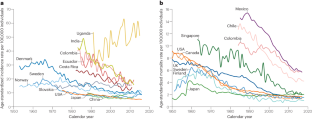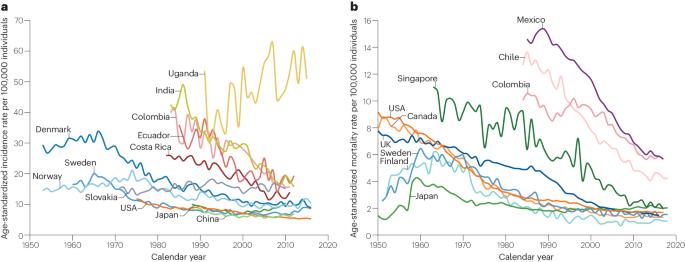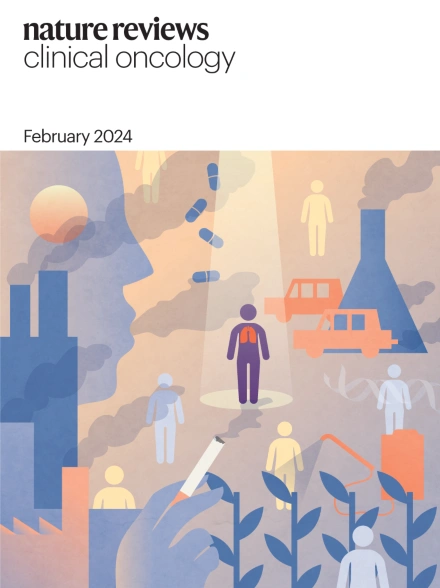人类乳头瘤病毒相关癌症过去、现在和未来的流行病学:走向预防和消除
IF 81.1
1区 医学
Q1 ONCOLOGY
引用次数: 0
摘要
宫颈癌是第一种被认为可以通过预防来消除的癌症,因此,从这种癌症的流行病学和预防中汲取的经验教训可以为其他癌症的防治策略提供信息。感染人类乳头瘤病毒(HPV)几乎会导致所有宫颈癌,以及很大一部分口咽癌、肛门癌和生殖器癌。20 世纪的预防工作以细胞学筛查为主,而现在和未来的 HPV 相关癌症预防工作则主要依靠 HPV 疫苗接种和分子筛查测试。在本综述中,我们将概述 HPV 相关癌症的流行病学、其疾病负担、过去和当代的预防干预措施如何影响其发病率和死亡率,以及消除这些疾病的可能性。我们特别关注对预防工作影响最大的辅助因素,如奇偶性和人体免疫缺陷病毒感染,以及决定健康的社会因素。鉴于人类乳头瘤病毒相关癌症的发病率和死亡率仍与个人的社会经济地位和国家的人类发展指数密切相关,除非预防工作注重健康公平,并致力于初级和二级预防,否则消除人类乳头瘤病毒的努力不可能取得成功。本文章由计算机程序翻译,如有差异,请以英文原文为准。


Epidemiology of HPV-associated cancers past, present and future: towards prevention and elimination
Cervical cancer is the first cancer deemed amenable to elimination through prevention, and thus lessons from the epidemiology and prevention of this cancer type can provide information on strategies to manage other cancers. Infection with the human papillomavirus (HPV) causes virtually all cervical cancers, and an important proportion of oropharyngeal, anal and genital cancers. Whereas 20th century prevention efforts were dominated by cytology-based screening, the present and future of HPV-associated cancer prevention relies mostly on HPV vaccination and molecular screening tests. In this Review, we provide an overview of the epidemiology of HPV-associated cancers, their disease burden, how past and contemporary preventive interventions have shaped their incidence and mortality, and the potential for elimination. We particularly focus on the cofactors that could have the greatest effect on prevention efforts, such as parity and human immunodeficiency virus infection, as well as on social determinants of health. Given that the incidence of and mortality from HPV-associated cancers remain strongly associated with the socioeconomic status of individuals and the human development index of countries, elimination efforts are unlikely to succeed unless prevention efforts focus on health equity, with a commitment to both primary and secondary prevention. Lessons from the prevention of cervical cancer, the first cancer type deemed amenable to elimination, can provide information on strategies to manage other cancers. Infection with human papillomavirus (HPV) causes virtually all cervical cancers and an important proportion of other cancer types. The authors of this Review discuss the epidemiology of HPV-associated cancers and the potential for their elimination, focusing on the cofactors that could have the greatest effect on prevention efforts and health equity.
求助全文
通过发布文献求助,成功后即可免费获取论文全文。
去求助
来源期刊
CiteScore
99.40
自引率
0.40%
发文量
114
审稿时长
6-12 weeks
期刊介绍:
Nature Reviews publishes clinical content authored by internationally renowned clinical academics and researchers, catering to readers in the medical sciences at postgraduate levels and beyond. Although targeted at practicing doctors, researchers, and academics within specific specialties, the aim is to ensure accessibility for readers across various medical disciplines. The journal features in-depth Reviews offering authoritative and current information, contextualizing topics within the history and development of a field. Perspectives, News & Views articles, and the Research Highlights section provide topical discussions, opinions, and filtered primary research from diverse medical journals.

 求助内容:
求助内容: 应助结果提醒方式:
应助结果提醒方式:


